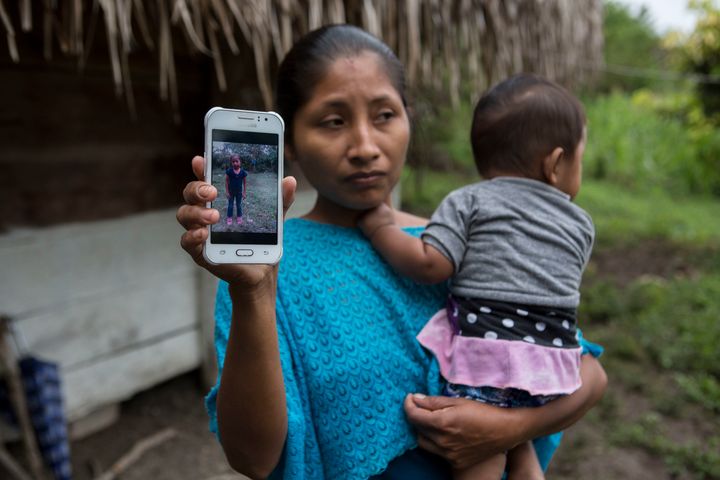Jackelin Caal, the 7-year-old who died in Border Patrol custody this month after crossing into the United States through the New Mexico desert with her father, didn’t make her dangerous and ultimately fatal journey to this country alone.
Some 161 other migrants, including about 50 children traveling alone, were in the group that crossed through the desert with Caal and her father to the remote outpost of Antelope Wells in New Mexico.
Many migrants know that pushing into far-flung crossings over rough terrain means taking huge risks. But U.S. government policy has left them few other options: As President Donald Trump’s administration has made it harder to request asylum at legal ports of entry and deployed the military to the border to scare away asylum-seekers, migrant families are crossing in more isolated and treacherous areas.

“Forcing them into very dangerous and remote areas is going to result in even more deaths like what we saw with Jackelin Caal,” El Paso, Texas, immigration attorney Melissa Untereker told HuffPost. “It’s only going to increase with policies like these that keep people from seeking asylum at ports of entry safely, securely and quickly.
Under both Democratic and Republican administrations, the Border Patrol has spent the last three decades pushing migrants away from populated border crossings to more dangerous desert areas ― a strategy dubbed prevention through deterrence. Trump doubled down on that strategy by making it harder for asylum-seeking migrants to make their claims at legal ports of entry and stationing military personnel near major crossings to dissuade migrants from crossing without authorization and turning themselves over to Border Patrol agents to start their humanitarian claims.
The effects of Trump’s new policies are most evident in the area of the border where the Caal family crossed. In November 2017, Border Patrol apprehended 379 migrants traveling together as families through the El Paso sector, which stretches from West Texas through New Mexico and includes a swath of the Chihuahuan Desert.
By last month, that number had skyrocketed past 6,400 — a nearly 1,600 percent jump and the highest percentage increase of any sector along the U.S.-Mexico border.
In recent years, the total numbers for unauthorized crossings have remained at their lowest levels since the 1970s. But because those who are making unauthorized crossings these days are much more likely to be adults traveling with their kids or children traveling alone, the White House strategy could lead to more deaths of minors like Caal.
The changes in border-crossing patterns aren’t coincidental. Homeland Security Secretary Kirstjen Nielsen has repeatedly implored asylum-seeking migrants to cross at legal ports of entry. But at the same time, the Trump administration has kept many migrants from doing so.
In May of this year, Customs and Border Protection began placing agents along the international bridges connecting Mexico’s Ciudad Juárez to its sister city of El Paso, according to a report by Human Rights First. Those officers were charged with limiting the daily number of people who could start asylum claims ― a policy that Homeland Security officials say resulted from lack of processing space but that legal groups view as contrived and a violation of domestic and international law.
The month that the Trump administration imposed that so-called metering policy in El Paso, the number of migrant families that crossed without authorization roughly doubled, to about 1,600. The number of unaccompanied minors who crossed outside ports of entry also spiked.
That trend has been evident along the U.S.-Mexico border. Last year, roughly one-third of migrant families traveling together came through a legal port of entry. In the first two months of this year, that number is down to about 16 percent, CBP statistics show.
The number of families crossing through the El Paso sector roughly doubled again in October ― the same month that Trump announced a deployment of thousands of U.S. military support personnel. More than 23,000 migrants traveling as families like the Caals crossed through the El Paso sector in the last 12 months. That’s more than triple the number in the same period the year before.
“The trend lines are quite dramatic,” said Shaw Drake, a policy counsel for the ACLU Border Rights Project. “When you cut off safe passage routes or, certainly, when you cut off access to presenting at ports of entry, you know you are no doubt putting pressure on people to move to more dangerous crossing zones.”
Caal’s death in Border Patrol custody has focused intense scrutiny on the agency, as members of Congress and Homeland Security’s Office of Inspector General investigate whether agents followed safety protocols.
But what already appears clear is that crossing in such a remote area played a decisive role in the child’s death. She began vomiting, then seizing in a transport bus from Antelope Wells to the Border Patrol station at Lordsburg, New Mexico. Far from medical facilities, agents had little choice but to keep heading toward their destination, a Customs and Border Protection official told reporters last week ― leaving the child without care for 90 minutes, followed by medical evacuation by helicopter.
Had Caal and her father crossed through a legal port of entry in a more populated area like the city El Paso or San Diego, the child would have been at all times a short ambulance ride from a hospital.
Ruben Garcia, the director of Annunciation House ― the shelter that is caring for the girl’s father, Nery Caal ― called attention to the shifting border-crossing patterns at a press conference on Sunday, where he delivered a statement prepared by lawyers working for the Caal family.
“What people are doing is they’re going further and further out ― and that is dangerous. It is endangering the lives and welfare of families and obviously of children,” Garcia said. “What is most disconcerting is that that is the intention of government policy. It is the intention of government policy to prevent people from exercising their rights.”
